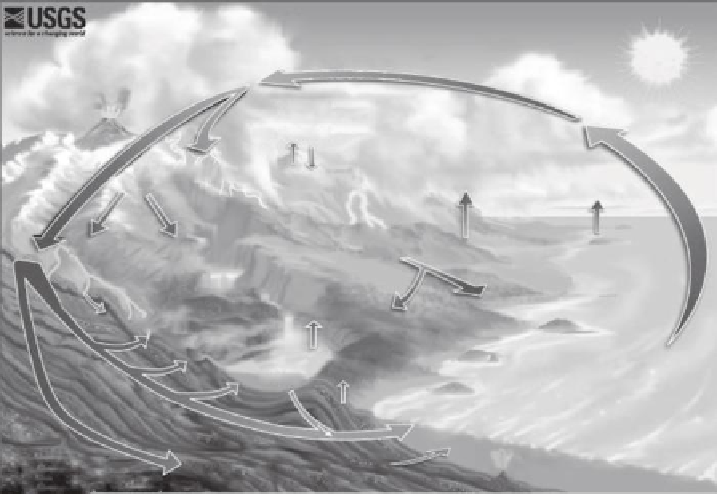Environmental Engineering Reference
In-Depth Information
Volcanic
steam
Water in the atmosphere
Condensation
Sublimation
Ice and
snow
Evapotrans-
piration
Precipitation
Desublimation
Evaporation
Fog
drip
Surface
runoff
Snowmelt runoff
Dew
Streamflow
Infiltration
Evaporation
Seepage
Flora and
fauna
Spring
Plant
uptake
Fresh-
water
Oceans
Vents and
volcanoes
Groundwater storage
FIGURE 28.1
(See color insert.)
Natural water cycle is a balance that is dependent on many different inputs. As human activ-
ity changes these inputs, such as amount stored in groundwater or evapotranspiration from increased agricul-
tural activity, the cycle can be disrupted or altered. (From USGS.
Summary of the Water Cycle
. [cited February 18,
2013]; Available at http://ga.water.usgs.gov/edu/watercyclesummary.html, 2013.)
energy and/or material input to treating water, it is important to consider ways to mitigate
the stress on the natural water cycle or to replenish the existing cycles leading to inno-
vative science and technology development for more eficient ways of energy and water
distribution and production.
Special attention to the energy-water nexus is essential because of increasing popula-
tion needs driving increasing energy demands, and signiicantly diminished freshwater
supplies [4]. For example, the US Department of Energy (USDOE) reports that freshwater
withdrawals surpass precipitation in numerous regions of the United States, most sig-
niicantly in the southwest, the high plains, California, and Florida, as shown in Figure
28.2 [5]. In addition, some groundwater levels in the United States have seen drops of
300-900 ft during the past 50 years because the withdrawal rate is faster than the aquifer
recharge rate, causing shortages and increased salinity, as summarized in Table 28.1 [5] for
a few geographic locations around the United States. For example, in Dare County, North
Carolina, the population increased by 48% from 1991 to 2009, causing an increased demand
on groundwater resources. Compared with the late 1980s, the salinity of the groundwater
resources in the Dare County area has risen from 1000 to 2500 mg/l, requiring desalina-
tion before distribution [6].
In this chapter, the focus is on water use for energy needs, and the technology solutions
available including those based on nanotechnology and/or pathways that can help mini-
mize and eventually eliminate water use for energy production and use. Therefore, the
purpose of this chapter is to provide a review of water use for a variety of common energy
generation systems, identify challenges, and suggest some technology solutions with exam-
ples for the challenges toward solving the problems arising from the energy-water nexus.

